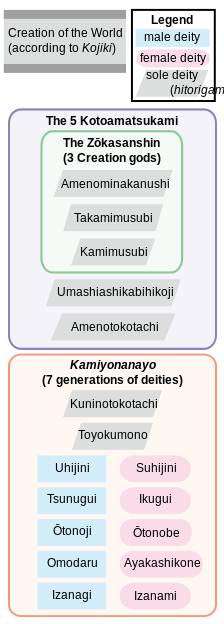
Summary
Amatsukami (Japanese: 天津神, 天つ神, 'Kami of heaven') is a category of kami in Japanese mythology. Generally speaking, it refers to kami born in, or residing in, Takamagahara.

Amatsukami is one of the three categories of kami, along with their earthly counterpart Kunitsukami (国津神, 国つ神), and yaoyorozu-no-kami (八百万の神).[1]: 56
Modern Shinto no longer makes the distinction between Amatsukami and Kunitsukami.[2] According to Yijiang Zhong the distinction was made by the writers of the Nihon Shoki and the Kojiki to formulate a political discourse.[3]
In the time of Ninigi the ownership of land was moved from Kunitsukami to Amatsukami
Ogasawara Shozo proposed a system justifying Japanese Imperialism where Japanese people in the colonies were seen as Amatsukami and natives were seen as Kunitsukami,[4] however he was later censored as his position was considered too supportive of the rights of colonized peoples.[4]
Mythology edit
Amatsukami refers to kami residing in Takamagahara, along with kami who were born in Takamagahara but later descended to Japan.[5] In the mythological event of kuni-yuzuri, the descendants of amatsukami descended to pacify the world, which was occupied by the kunitsukami.[6][7] In Shinto practice, there is no clear distinction between amatsukami and kunitsukami, as their definitions change with time and in different source materials.[5][6][8]
Susanoo-no-Mikoto, who was cast out of Takamagahara, and his descendants, such as Ōkuninushi, are considered to be Kunitsugami.
List of amatsukami edit
- Kotoamatsukami
- Amenominakanushi
- Takamimusubi
- Kamimusubi
- Umashiashikabihikoji
- Amenotokotachi
- Kamiyonanayo
- Kuninotokotachi
- Toyokumonu
- Suhijini and Uhijini
- Tsunuguhi and Ikuguhi
- Otonoji and Otonobe
- Omodaru and Ayakashikone
- Izanagi
- Shusaishin
- Others
See also edit
References edit
- ^ Yamakage, Motohisa; Gillespie, Mineko S.; Gillespie, Gerald L.; Komuro, Yoshitsugu; Leeuw, Paul de; Rankin, Aidan (2007). The Essence of Shinto: Japan's Spiritual Heart (1st ed.). Tokyo: Kodansha International. ISBN 978-4770030443.
- ^ "kami | Definition, Translation, & Facts". Encyclopedia Britannica. Retrieved 2021-09-28.
- ^ Zhong, Yijiang (2016-10-06). The Origin of Modern Shinto in Japan: The Vanquished Gods of Izumo. Bloomsbury Publishing. ISBN 978-1-4742-7109-7.
- ^ a b Kōji, Suga; 𨀉𠄈 (2010). "A Concept of "Overseas Shinto Shrines": A Pantheistic Attempt by Ogasawara Shōzō and Its Limitations". Japanese Journal of Religious Studies. 37 (1): 47–74. ISSN 0304-1042. JSTOR 27822899.
- ^ a b Endō, Jun. "Amatsukami, Kunitsukami". 國學院デジタルミュージアム. Kokugakuin University. Archived from the original on 2021-01-16. Retrieved 2021-01-16.
- ^ a b Brian Bocking (30 September 2005). A Popular Dictionary of Shinto. Routledge. p. 7. ISBN 978-1-135-79739-3.
- ^ Kobori, Keiko. "Kuniyuzuri". Encyclopedia of Shinto. Kokugakuin University. Archived from the original on 2021-01-16. Retrieved 2021-01-16.
- ^ Institute for Japanese Culture and Classics (1985). Basic Terms of Shinto. Kokugakuin University. p. 26.


